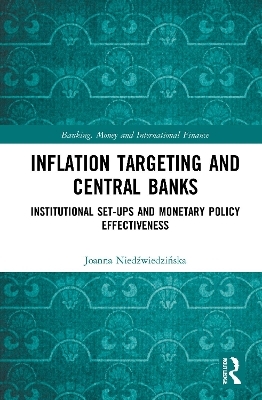
Inflation Targeting and Central Banks
Routledge (Verlag)
978-1-032-03826-1 (ISBN)
Over the last three decades, inflation targeting (IT) has become the most popular monetary policy framework among larger economies. At the same time, its constituting features leave room for different interpretations, translating into various central banks’ institutional set-ups. Against this backdrop, this book investigates the importance of institutional arrangements for policy outcomes. In particular, the book answers the question of whether there are significant differences in IT central banks’ institutional set-ups, and—if yes—whether they influence the ability of monetary authorities to meet their policy goals.
The book examines around 70 aspects related to independence, accountability and transparency of 42 IT central banks over the last 30 years. Based on the analysis, it can be concluded that the quality of the institutional set-ups materially affects monetary policy effectiveness. In fact, a visible improvement of institutional arrangements resulting from pursuing an inflation targeting strategy can be treated as its lasting contribution to central banking. Thus, despite the recent critique of the framework, its prospects continue to be rather favourable.
Overall, for the advocates of inflation targeting, the findings of the book can be seen as identifying the sources of IT strengths, while for IT opponents, they may be viewed as indicating which elements of IT institutional set-ups should be kept even if the need to replace this strategy with another regime will, indeed, result in a change. Given the role monetary policy plays within the economy, such knowledge may have significant implications. Therefore, the book will be relevant for different audiences, including scholars and researchers of monetary economics and monetary policy, and will be essential reading for central banks already pursuing an IT strategy or those preparing to adopt one.
Importantly, the book includes supplementary indices of proposed institutional arrangements that assess a range of aspects related to IT central bank’s independence, accountability, and transparency. Readers thus have access to the author’s full database, which covers individual indices for all monetary authorities investigated across the given period of analysis.
Joanna Niedźwiedzińska is an economist who has worked in central banks for over 15 years. She started her career at the National Bank of Poland, but worked also a few years at the European Central Bank. She is now the head of the Division of Monetary Policy Strategy in the Department of Economic Analysis at the National Bank of Poland. As well as dealing with issues related to monetary policy strategy, she focuses on the central bank’s communication of monetary policy decisions.
Introduction 1. Indicating the origins, essential features and prospects of an inflation targeting framework 2. Describing differences in implementing key elements of an inflation targeting strategy 3. Constructing indices comparing institutional set-ups of inflation targeting central banks 4. Analysing the implications of differences in institutional set-ups of inflation targeting central banks Conclusions
| Erscheinungsdatum | 15.03.2022 |
|---|---|
| Reihe/Serie | Banking, Money and International Finance |
| Zusatzinfo | 48 Tables, black and white; 185 Line drawings, black and white; 185 Illustrations, black and white |
| Verlagsort | London |
| Sprache | englisch |
| Maße | 156 x 234 mm |
| Gewicht | 476 g |
| Themenwelt | Geisteswissenschaften ► Geschichte |
| Wirtschaft ► Volkswirtschaftslehre ► Finanzwissenschaft | |
| Wirtschaft ► Volkswirtschaftslehre ► Makroökonomie | |
| Wirtschaft ► Volkswirtschaftslehre ► Wirtschaftspolitik | |
| ISBN-10 | 1-032-03826-8 / 1032038268 |
| ISBN-13 | 978-1-032-03826-1 / 9781032038261 |
| Zustand | Neuware |
| Informationen gemäß Produktsicherheitsverordnung (GPSR) | |
| Haben Sie eine Frage zum Produkt? |
aus dem Bereich


